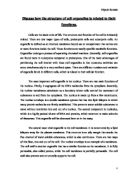Endoplasmic Rectriculum
Endoplasmic rectriculum (ER) consists of a network of folded membranes forming sheets, tubes or flattened sacs in the cytoplasm. It originates from the outer membrane of the nucleus, to which it often remains attached.
The ER can carry numerous ribosomes. The presence of ribosomes gives it a granular appearance, and in this condition ER is described as rough endoplasmic rectriculum (RER). RER is the site of the synthesis of proteins, which are packaged up in membranous vesicles and either move about the cell or are dispatched from it.
Smooth endoplasmic rectriculum (SER) does not have this coating of ribosomes. SER is concerned with lipid metabolism.
Ribosomes
Ribosomes are minute cottage-leaf shaped structures with a diameter of 20pm that consist of two sub-units. There are several thousand ribosomes per cell. Ribosomes are the site of protein synthesis. Ribosomes lying free in the cytoplasm are the site of synthesis for the proteins retained within the cell, whereas ribosomes bound to the endoplasmic rectriculum produce proteins that are subsequently secreted outside the cell.
Golgi Apparatus
The golgi apparatus consists of a stack of flattened membranous sacs. This organelle is present in all cells, but most prominent in those that are metabolically active. The golgi apparatus is the site of the synthesis of biochemicals; these are packaged into swellings at the margin of the sac which become pinched off as vesicles. The golgi apparatus also collects proteins and lipids made in the ER by the fusion of vesicles pinched off from the ER with its own flattened sacs. In the golgi apparatus, additional substances are added and the products are repackaged into fresh vesicles which then cut off and move to other parts of the cell where the secrets are discharged and deposited.
Lyosomes
Lyosomes are small spherical vesicles, 0.2-0.5pm in diameter or larger (Particularly in plant cells). The lyosome is bounded by a single membrane and contains a concentrated mixture of hydrochloric digestive enzymes. If these digestive enzymes were not kept enclosed in a membranous sac they would attack other cell organelles. These enzymes are used in dissolution and digestion of redundant structures or damaged macromolecules from within or outside the cell.
Vacuoles
Vacuoles are fluid-filled cavities bounded by a single membrane. They are formed either by the infolding and pinching off of part of the cell membrane, or by enlargement of a vesicle cut off the golgi apparatus, Young plant cells usually contain several small vacuoles which in the mature cell, have united to form a large permanent central vacuole, occupying 80 per cent of the cell volume. The plant vacuole is filled with a liquid known as cell sap, an aqueous solution of dissolved food materials, ions, waste products and pigments. The membrane around this type of vacuole is known as the tonoplast.
The vacuoles of animal cells are usually very much smaller and less permanent. Small vacuoles are often called vesicles.
Mitochondria
Mitochondria appear in the electron micrographs mostly as rod-shaped cylindrical organelles. Mitochondria occur in all cells in very large numbers, possibly more than a thousand of them in a cell that is metabolically very active. They vary in size within the range 0.5-1.5pm wide and 3.0-10pm long. Each mitochondrion is bounded by a double membrane, the outer being a smooth continuous boundary. The inner membrane is infolded to form partitions called cristae, which partially divide the interior.
Chloroplasts
Chloroplasts are members of a group of organelles known as plastids. Plastids normally contain pigments such as chlorophylls and carotenoids. Photosynthesis occurs in chloroplasts in all green plants. They are 4-10pm long and 2-3pm wide. The chloroplast os bounded by a double membrane. The outer membrane is a smooth continuous boundary; the inner gives rise to strands of branching membranes called lamellae or thylakoids extending throughout the organelle. The interior of the chloroplast is divided into the grana, which are surrounded by stroma. In the grana the thylakoids are stacked in flat, circular piles and contain photosynthetic pigments. In the stroma the thylakoids criss-cross loosely, suspended in an aqueous matrix containing ribosomes, liquid droplets and small starch grains.








